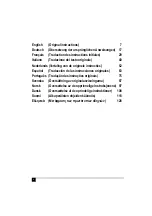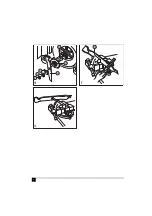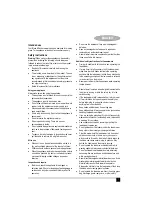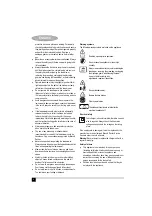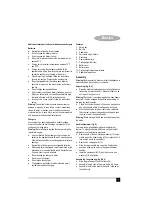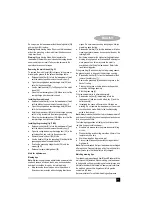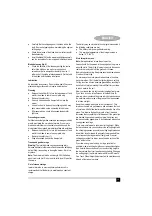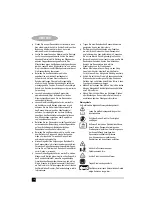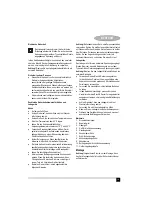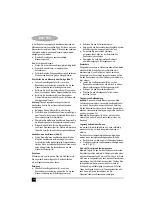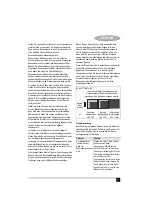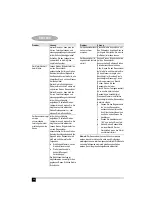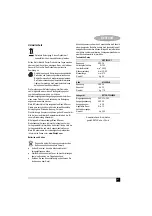
12
ENGLISH
Avoid mowing when the grass is wet. Wet grass may
form clumps which interfere with the mulching action
and reduce run time. The best time to mow grass is in
the afternoon when the grass is dry and the newly cut
area will not be exposed to direct sunlight.
For best mulching performance, set the cutting height to
remove about one third of the grass length, ideally no
more than 38 mm at one time. If the lawn is overgrown,
it may be necessary to increase the cutting height to
reduce the pushing effort and to prevent overloading the
motor.
For extremely heavy mulching, it is advisable to first cut
at a high cutting height setting, and then cut to the final
cutting height or make narrower cuts and mow slowly.
For best performance, keep the lawnmower housing free of
built-up grass:
Release the bail bar (2) to turn the lawnmower off and
wait for the blade to come to a complete stop.
Remove the safety key (1) and the battery pack (6) and
turn the lawnmower on its side.
Use a blunt scraper to remove the accumulation of
grass in the blade area. Be careful of the sharp edges of
the blade. Clean more often when cutting lush grass,
and always after every use.
Certain types of grass or grass conditions may require that
an area be mulched a second time to fully disperse the grass
throughout the lawn.
If cutting a second time, it is advisable to cut perpendicular
(across) the first cut pattern but do not change the cutting
pattern in any way that would mean mowing downhill.
Change your cutting pattern from week to week. This
will help prevent matting of the lawn.
Maintenance
Your Black & Decker appliance has been designed to
operate over a long period of time with a minimum of
maintenance. Continuous satisfactory operation depends
upon proper appliance care and regular cleaning.
Keep the appliance clean and dry.
Removing and installing the blade (fig. R & S)
Warning!
Do not touch the blade before the safety key has
been removed and the blades have come to a complete
stop.
Release the bail bar (2) to turn mower off, wait for the
blade to stop and remove the safety key (1).
Cut a piece of wood (approximately 50 mm x 100 mm x
600 mm long) to use to keep the blade from turning
while removing the flange nut.
Turn the mower on its side.
Warning!
Wear gloves and proper eye protection. Be careful
of the sharp edges of the blade.
Position the wood (31) and remove the flange nut (33)
with a 19 mm wrench (32) (fig. R).
Remove the square metal blade spacer (34), the square
plastic blade insulator (35) and the blade (36) (fig S).
Examine the blade insulator (37) for damage and
replace if necessary.
When fitting the blade, make sure that the grass side of the
blade will face the ground when the mower is returned to its
normal upright position.
After installing the blade, place the blade insulator (37)
on the blade such that the raised lips on one side
engage with the edges of the blade (36).
Install the blade spacer (38) so that it sits inside the
raised lips on the other side of the blade insulator (37).
Be sure to align the flats in the hole of the blade spacer
(38) with the flats of the shaft, rotating the blade and
blade insulator together as necessary.
Position the piece of wood (31) to keep the blade from
turning (fig. R).
Install the flange nut (33) with the flange against the
square metal blade spacer (34) and tighten.
Blade sharpening
Keep the blade sharp for best performance. A dull blade
does not cut grass cleanly or mulch properly.
Warning!
Always make sure that the safety key is removed.
Warning!
Wear proper eye protection while removing,
sharpening and installing a blade.
Sharpening the blade twice during a mowing season is
usually sufficient under normal circumstances. Sand causes
the blade to dull quickly. If your lawn has sandy soil more
frequent sharpening may be required.
Replace bent or damaged blades immediately.
When sharpening the blade:
Make sure that the blade remains balanced.
Sharpen the blade at the original cutting angle.
Sharpen the cutting edges on both ends of the blade,
removing equal amounts of material from both ends.
To sharpen a blade in a vice (fig. T)
Release the bail bar (2) to turn the lawnmower off and
wait for the blade to come to a complete stop.
Remove the safety key (1) and the battery pack (6) and
turn the lawnmower on to its side.
Remove the blade (36) from the mower, see the
instructions for removing and installing blades.
Warning!
Wear proper eye protection and gloves and be
careful of the sharp edges of the blade.
Put the blade (36) in a vice.
Содержание GRC4700
Страница 1: ...Powerful Solutions TM www blackanddecker eu 1 7 2 4 5 6 3 8 10 9 11 GRC4700 ...
Страница 3: ...3 3 11 12 13 5 14 ...
Страница 4: ...4 15 16 7 1 17 18 19 20 22 21 23 6 9 8 ...
Страница 5: ...5 2 3 28 25 26 27 25 29 30 24 31 33 32 ...
Страница 6: ...6 ...


